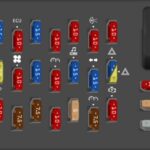Navigating the world of automotive diagnostics can be confusing, especially when it comes to connectors. You might have heard terms like OBD, OBD2, and even seen references to 6-pin connectors. Understanding the differences, particularly between a 6 pin OBD and an OBD2 connector, is crucial for anyone involved in vehicle maintenance and repair. This article will clarify these distinctions, helping you choose the right tools and adapters for your diagnostic needs.
Decoding OBD and OBD2: The Basics
OBD stands for On-Board Diagnostics. It’s a generic term referring to a vehicle’s self-diagnostic and reporting capability. Early OBD systems were not standardized, leading to a variety of connectors and communication protocols used by different manufacturers.
OBD2, or On-Board Diagnostics II, is the standardized successor to OBD. Mandated in the United States for all cars manufactured after 1996, and subsequently adopted in other regions, OBD2 provides a universal standard for vehicle diagnostics. This standardization includes the type of connector, the communication protocols, and the diagnostic trouble codes (DTCs).
The 6-Pin OBD Connector: A Closer Look
The mention of a “6 pin OBD connector” often brings confusion because OBD2 is defined by a 16-pin connector (SAE J1962). So, what exactly is a 6-pin OBD connector referring to?
In many cases, especially within specific vehicle brands or older systems, a 6-pin connector might be used for diagnostic purposes. Ducati motorcycles, for example, are known to utilize a 6-pin diagnostic connector on many of their models, particularly pre-2021 bikes as mentioned in a forum discussion. This 6-pin connector is not OBD2 standard. It’s a manufacturer-specific or system-specific connector that serves a diagnostic function but operates outside the standardized OBD2 framework.
It’s important to note that even if a connector has 6 pins and is used for diagnostics, it doesn’t automatically make it an “OBD” connector in the standardized sense of OBD2. The term “OBD” in this context is being used more loosely to describe a diagnostic port, rather than adhering to the strict definition of OBD2. Furthermore, even within a 6-pin connector, not all pins might be active or used for communication; sometimes, as few as 4 pins are actually in use, as also noted in user discussions about Ducati adapters.
OBD2 Connectors: The Universal Standard Explained
The OBD2 connector is characterized by its 16-pin, trapezoidal shape. This connector is designed to be universally compatible across all OBD2-compliant vehicles, regardless of manufacturer. The standardization of OBD2 extends beyond just the physical connector to include:
- Pinout: The function of each of the 16 pins is defined, ensuring consistent communication.
- Communication Protocols: OBD2 specifies several communication protocols (like CAN, ISO 9141-2, PWM, VPW, and ISO 14230-4), allowing diagnostic tools to communicate with the vehicle’s computer systems.
- Diagnostic Trouble Codes (DTCs): A standardized system of codes is used to report vehicle problems, making diagnosis more consistent and efficient.
Because of this standardization, a generic OBD2 scanner can be used to read diagnostic information from any OBD2-compliant vehicle, making vehicle repair and maintenance significantly more accessible.
6-Pin OBD vs OBD2: Key Differences Summarized
| Feature | 6-Pin OBD Connector (Non-Standard) | OBD2 Connector (Standard) |
|---|---|---|
| Standard | Non-standard, often proprietary | Standardized (SAE J1962) |
| Pin Count | 6 pins (sometimes fewer pins used) | 16 pins |
| Usage | Brand-specific or system-specific | Universal for OBD2 vehicles |
| Compatibility | Limited to specific vehicles/systems | Universal OBD2 compliance |
| Protocols | Manufacturer-specific protocols | Standardized OBD2 protocols |
Adapting 6-Pin OBD to OBD2 Systems
If you encounter a vehicle or system using a 6-pin diagnostic connector and need to interface with standard OBD2 tools, adapters are the solution. As mentioned in the initial forum post, adapters are available to convert from a 6-pin connector to the 16-pin OBD2 connector.
These adapters essentially remap the signals from the 6-pin connector to the appropriate pins on the OBD2 connector, allowing an OBD2 scanner to communicate with the vehicle. It’s crucial to choose the correct adapter that is designed for the specific vehicle brand or system you are working with (e.g., a Ducati 6-pin to OBD2 adapter). Using the wrong adapter can lead to communication issues or potentially damage your diagnostic equipment or the vehicle’s electronic systems.
When using adapters, it’s generally better to use a single, direct adapter rather than “adapters on adapters” as suggested in the forum, to minimize potential signal loss or connection instability.
Choosing the Right Connector and Adapter for Diagnostics
For modern vehicles (post-1996 in many regions), the OBD2 connector is the standard, and most generic OBD2 scanners will connect directly. However, when working with older vehicles, motorcycles, or specific brands like Ducati which may utilize non-standard connectors, you need to:
- Identify the connector type: Determine if the vehicle uses a standard 16-pin OBD2 connector or a different type, like a 6-pin connector.
- Verify compatibility: Ensure your diagnostic tool and any adapters you use are compatible with the vehicle’s make, model, and year.
- Select the correct adapter: If an adapter is needed, choose one specifically designed for the connector type and vehicle you are working with.
By understanding the differences between 6-pin OBD and OBD2 connectors, and the role of adapters, you can confidently approach vehicle diagnostics and ensure you have the right connections for effective troubleshooting and repair.
References
